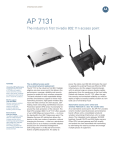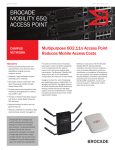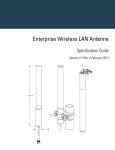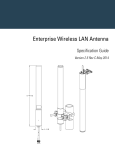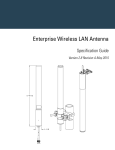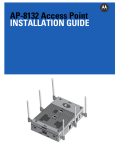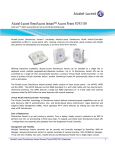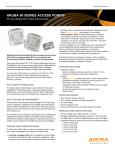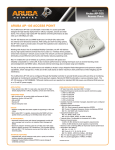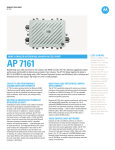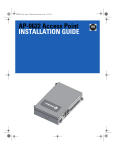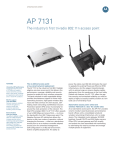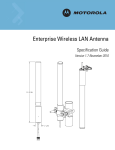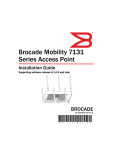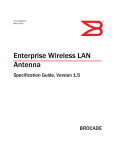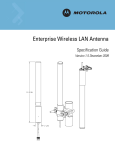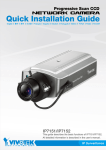Download Zebra ML-5299-BYGA15-012 network antenna
Transcript
SPECification Sheet AP-7131-GR The industry’s first FIPS 140-2 Level2 Validated 802.11n Adaptive services access point FEATURES Unmatched Security for Federal and Government agencies FIPS 140-2 Level2 Validated; CC with US Government Wireless LAN Access System Protection Profile* Unmatched RF performance Conducted transmit power of 27.7dBm and superior receive sensitivity provide best in class range, coverage and application performance, even in harsh RF conditions 802.11n support with 3X3 MIMO Delivers maximum wireless network throughput to support virtually any government application, including voice and video The re-defined access point: a true wired network replacement The AP-7131-GR is the industry’s first 802.11a/b/g/n Adaptive Services Access Point that delivers the performance, coverage, reliability and security required to enable the truly wireless agency. The band-unlocked dual-radio design provides simultaneous support for three major networking functions: high-speed wireless data, voice and video services for client access, self-healing mesh networking and Wireless Intrusion Prevention System (IPS) sensor functionality for around the clock protection of the network. The fully DFS compliant 802.11n Draft 2.0 AP-7131-GR offers speeds of up to 600 Mbps per Access Point — six times the bandwidth of an 802.11a/g access point. The Adaptive Services AP architecture allows the device to offer two modes of operation, without changing the firmware — either as a stand-alone access point or as a wireless switch adopted access point for centralized management. Self-configuration in an 802.3af environment further simplifies deployment. The ability to power both radios over 802.3af eliminates the need to upgrade the existing Power-over-Ethernet (PoE) infrastructure. And the elegant industrial design with an optional snap-on antenna façade enables agency wide deployment — from the warehouse to the carpeted office space. Packed with features, the AP-7131-GR offers the gap-free security and unmatched reliability you need to deploy a highly successful mobility solution at a low total cost of ownership (TCO). Security Credentials The AP-7131-GR provides unmatched security for Federal and Government agencies made possible by the following security credentials: • FIPS 140-2 Level2 Validated • CC with US Government Wireless LAN Access System Protection Profile, in process Figure1: Motorola AP-7131-GR with Band-Unlocked Radios Industry’s First Adaptive Services Access Point for Concurrent Services Radio 1 Radio 2 Client access and mesh in 2.4GHz -orDual-band Wireless IPS Sensor Client access and mesh in 5GHz -orDual-band Wireless IPS Sensor With two band-unlocked radios integrated into a single access point, wireless traffic can be segmented as needed between two radios to ensure performance levels for wireless access and backhaul, and any of these radios can provide around-the-clock dedicated dual-band sensing. The need to purchase, power and manage dedicated sensors is eliminated — an estimated savings of $300-$400 per sensor — providing the highest level of security for the wireless LAN at the lowest possible cost. Band-unlocked dual band design The ability to dedicate multiple radios to multiple functions increases security without increasing costs; band-unlocked radios enable 24x7 dual band Wireless IPS sensing on both 2.4GHz and 5GHz with concurrent 802.11a/b/g/n client access and mesh Gap-free dedicated 24x7 sensing via triple methodology rogue AP detection: on-channel, mobile unit and dedicated radio dual-band scanning Around the clock network protection through instant rogue detection 2 Standalone access point: wired and wireless ‘Network in a box’ for Government Agencies As a standalone access point, the AP-7131-GR provides small to medium-sized agencies and branch offices with a consolidated wired and wireless networking infrastructure, all in a single device. The integrated router, gateway, firewall, DHCP and AAA Radius servers, IPSec VPN, hot-spot gateway and Power-over-Ethernet (PoE) simplify and reduce the costs associated with networking by eliminating the need to purchase and manage multiple pieces of equipment. Centrally managed Access Point: Adaptive AP Mode The AP-7131-GR is designed to cost-effectively meet the needs of large, distributed agencies by converging the functionality of a thick access point and thin access port into a single device. Adaptive mode enables the deployment of a fully featured intelligent access point that can be centrally configured and managed via a Motorola wireless switch in either the headquarters or a network operations center (NOC). All traffic between the adaptive access points and the wireless switch is secured through an encrypted tunnel. And in the event of a WAN, distribution or core network failure, this fully independent configuration offers a Remote Site Survivability (RSS) feature that enables the delivery of secure uninterrupted wireless service in the remote location, offering unparalleled network resiliency. Gap-free security In addition to the FIPS 140-2 Level2 validation and CC in-process security credentials, to achieve true gap-free security you need gap-free rogue detection, requiring dedicated dual-band sensing of 2.4GHz and 5GHz wireless LANs — typically provided by a standalone sensor. The AP-7131-GR is the first a/b/g/n access point to offer multiple concurrent services on a single platform — around-the-clock dedicated dual-band sensing as well as the ability to carry wireless traffic — eliminating the need for separate devices. Integrated Wireless IPS sensor firmware enables the configuration of one radio for 24x7 rogue detection and termination, while a second radio can be dedicated to wireless traffic. As a result, government agencies can now deploy the most robust Wireless IPS solution available at a lower cost — the need and cost to purchase, deploy and manage dedicated sensor hardware is eliminated. In addition, stateful firewall, encryption and authentication support key standards-based security protocols that ensure government-level protection for the wired and wireless network infrastructure. This powerful feature set enables security to be administered by either local, non-technical staff or remote IT professionals at your headquarters. Mesh: cost-effective networking for challenging locations Mesh functionality enables the cost-effective wireless extension of the agency network to areas where Ethernet or fiber cabling is cost-prohibitive or otherwise impractical. Mesh functionality includes multi-node, multi-link networks as well as simple point-to-point bridging to connect two wired networks. Self-healing mesh ensures continuity of service in the event of a wired or wireless network failure. The self-forming highly resilient, VLAN and WMM QoS-aware mesh technology enables agencies to wirelessly extend reliable high-performance voice, data and video services to workers in remote and outdoor locations. End-to-end solution: from 802.11n network design to everyday support Motorola provides full life-cycle support for your 802.11n mobility deployment, from network design to day-to-day support. Motorola’s RF Management suite provides a comprehensive planning tool that enables the easy creation of a well-designed 802.11n wireless LAN, eliminating the high cost associated with an iterative trial-and-error approach and multiple site surveys. Motorola Professional Services offer expertise to assist with assessment through implementation of your mobility solution. Once your Motorola mobility solution is deployed, our responsive Customer Services keep your solution up and running, with maximum uptime — reducing your total cost of ownership. Government-class manageability — and a rapid return on investment (ROI) You can count on this multi-function multi-purpose device to deliver a rapid return on investment. The AP-7131-GR can be deployed as a standalone or centrally managed device to provide wireless voice, data and video services, mesh backhaul and Wireless IPS sensor functionality, all in one device. This built-in flexibility simplifies the mobility architecture — there is less equipment to purchase and manage, reducing your capital and operational expenditures. Special features, such as spectrum analysis, allow you to easily and remotely manage distributed networks. And with Motorola’s RF Management Suite (RFMS), you enjoy unified management of all your AP-7131-GR access points, enabling simplified, cost-effective planning, deployment and monitoring of large AP-7131-GR networks. For more information on how your agency can benefit from the AP-7131-GR, please visit us on the web at www.motorola.com/ap-7131-gr or access our global contact directory at www.motorola.com/enterprisemobility/contactus AP-7131-GR Specifications 802.11n Draft 2.0 Capabilities Configurations: Above drop ceiling, under ceiling or on wall LEDs: 6 top mounted LEDs, 1 bottom mounted LED, with multiple modes indicating 802.11a/g/n activity, power, Ethernet adoption, Wireless IPS and errors Uplink: 2 ports (GE1, GE2) Auto-sensing 10/100/1000 Base-T Ethernet; 802.3af on GE1 LAN port Performance Characteristics Antenna connectors: RP-SMA Dimensions : Console port: RJ45 Console Port • • • • 3X3 MIMO with 2 Spatial Streams 20 MHz and 40 MHz Channels 300 Mbps Data Rates per Radio Packet Aggregation (AMSDU, AMPDU) • Reduced Interframe Spacing • 802.11 DFS • MIMO Power Save (Static and Dynamic) 5.50 in. L x 8.00 in. W x 1.5 in. H 13.97 cm L x 20.32 cm W x 3.81 cm H Weight: 2.67 lbs/1.21 kg Housing: Metal, plenum-rated housing (UL2043) Available mounting: No additional hardware required to mount User Environment Operating Temperature: -4°F to 122°F/-20°C to 50°C Storage Temperature: -40°F to 158°F/-40°C to 70°C Operating humidity: 5 to 95% RH non-condensing Continued on next page... 3 Spectrum Analysis The ability to place a remote AP-7131-GR in Spectrum Analysis mode allows remote identification of local RF interference, enabling remote troubleshooting and issue resolution from the Network Operation Center (NOC) or other centralized location Adaptive AP: extending the agency Enables centralized management of mesh access points at remote sites including automatic firmware upgrades; provides site survivability for remote locations with 802.11a/b/g/n networks for unparalleled resiliency 802.3af dual-radio support Standard Power-over-Ethernet (PoE) provides power for both radios; intelligent power management enables selfconfiguration based on available power; eliminates the need to upgrade the PoE infrastructure Integrated Router, DHCP server, Stateful Packet Inspection Firewall, AAA server, NAT, and Hotspot Gateway Eliminates need to purchase and manage additional equipment; simplifies provisioning of network services and public access AP-7131-GR Specifications (continued) Operating altitude: 8000 ft./2438 m @ 82°F/28°C Operating bands: Storage altitude: 15000 ft./4572 m @ 53°F/12°C Electrostatic discharge: 15kV air, 8kV contact FCC 2.412 to 2.462 GHz 5.150 to 5.250 (UNII -1) 5.250 to 5.350 (UNII -2) 5.470 to 5.725 (UNII -3) 5.725 to 5.850 (ISM) Power Specifications Operating voltage: 36-57VDC Operating current: Not to exceed 600mA @ 48VDC Integrated PoE support: 802.3af support for dual radios, 802.3at (draft) EU 2.412 to 2.472 GHz 5.150 to 5.250 GHz 5.250 to 5.350 GHz 5.470 to 5.725 GHz (Country Specific) Japan 2.412 to 2.484GHz 4.900 to 5.000 GHz 5.150 to 5.250 GHz (W52) 5.250 to 5.350 GHz (W53) 5.470 to 5.725 GHz (W56) Regulatory Networking Specifications Product safety certifications: UL / cUL 60950-1, IEC / EN60950-1, UL2043, RoHS Layer 2 and Layer 3: Layer 3 routing, 802.1q, DynDNS, DHCP server/client and PPPoE Radio approvals: FCC (USA), Industry Canada, CE (Europe), TELEC (Japan), China, Korea, Australia Security: Stateful Firewall, IP filtering, NAT, 802.1x, 802.11i, WPA2, Triple-Methodology Rogue Detection: 24x7 dual-band WIPS sensing, MU-assisted, on-board IDS and secure guest access (HotSpot) Part Numbers Quality of Service (QoS): WMM, WMM-UAPSD, 802.1p, Diffserv and TOS AP-7131N-44040-FGR FIPS 140-2 Level 2 certified Dual Radio 802.11a/b/g Adaptive Services Access Point (US only) AP-7131N-44040-FWW FIPS 140-2 Level 2 certified Dual Radio 802.11a/b/g Adaptive Services Access Point (worldwide, not for US) Radio Specifications Wireless medium: Direct Sequence Spread Spectrum (DSSS), Orthogonal Frequency Division Multiplexing (OFDM) and Spatial multiplexing (MIMO) AP-7131N-44040-FIL FIPS 140-2 Level 2 certified Dual Radio 802.11a/b/g Adaptive Services Access Point (Israel) Network standards: IEEE 802.11a/b/g/n (Draft 2.0), 802.11d and 802.11i WPA2, WMM and WMM-UAPSD AP-7131N-66040-FGR Data rates supported: 802.11b/g: 1,2,5.5,11,6,9,12,18,24,36,48, and 54Mbps 802.11a: 6,9,12,18,24,36,48, and 54Mbps 802.11n: MCS 0-15 up to 300Mbps FIPS 140-2 Level 2 certified Dual Radio 802.11n Adaptive Services Access Point (US only) Operating channels: All channels from 4920 MHz to 5825 MHz Chan 1-13 (2412-2472 MHz) Chan 14 (2484 MHz) Japan only Actual operating frequencies depend on regulatory rules and certification agency AP-7131N-66040-FWW FIPS 140-2 Level 2 certified Dual Radio 802.11n Adaptive Services Access Point (worldwide, not for US) AP-7131N-66040-FIL FIPS 140-2 Level 2 certified Dual Radio 802.11n Adaptive Services Access Point (Israel) 50-14000-247R AP-7131-GR Power Supply AP-PSBIAS-1P3-AFR 23dBm (dependent on regulatory rules and certification agency) Single Port High Power 802.3at (Draft) Power Injector ML-2452-PTA2M3X3-1* Façade with 6 element antenna Module Transmit power adjustment: 1dB increments ML-2452-APA2-01* Indoor Dipole 3dBi Antenna ML-2452-PTA3M3-036* 3 Port MIMO Antenna Antenna configuration: 3x3 MIMO (transmit/receive on all three antennas) ML-5299-BYGA15-012* Yagi 4.9-5.8GHz Antenna Maximum available transmit power setting: Mesh networking Allows wireless extension of existing wired or wireless networks in remote or outdoor locations 802.11i, WPA2 and IPSec encryption End-to-end government-class wired and wireless security Wi-Fi Multimedia (WMM™), Quality of Service (QoS) and voice prioritization Superior performance for demanding mission critical applications, including voice and video MU Rate Limiting Allows client-based control of bandwidth, preventing any single user from impacting network availability WAN and LAN Ethernet ports Single device solution for both wired and wireless networking Java™ web-based graphical user interface TLS 1.0; SNMPv3; command line interface (CLI) Flexible management options; easy-to-use “anytime, anywhere” management Integrated VPN Cost-effective secure site-to-site communications DFS compliance Increased throughput through greater channel availability in the 5 GHz bands * For additional details on antennas refer to the: Enterprise Wireless LAN Antenna Guide. Continued on back... 4 Figure 2: AP-7131-GR for the Small/Medium Government Agencies DSL/Cable Modem Internet PoE Switch AP-7131 WAN Field Office Systems Server LAN Printer 802.11g/n (2.4GHz) 802.11a/n (5GHz) The diagram above illustrates the AP-7131-GR in action in small and medium-size government agencies, able to provide wireless connectivity for all clients (including .11n). Figure 3: AP-7131-GR for the Distributed Government Agency PoE Switch Cable Modem Headquarters/NOC Branch 1 AP-7131 Wireless IPS Sensor Spectrum Analyzer WAN RFMS with Wireless IPS NonPoE Switch RFS7000 Cluster ADSL Modem Branch 2 AP-7131 Mesh Wireless IPS Sensor The versatile AP-7131-GR also plays a crucial role in large distributed government agencies. When deployed in Adaptive AP Mode, this fully featured intelligent access point that can be centrally configured and managed via a Motorola wireless switch in either corporate headquarters or a network operations center (NOC). Yet in the event of a WAN, distribution or core network failure, the Remote Site Survivability (RSS) feature enables the AP-7131-GR to revert to standalone mode, ensuring the delivery of secure uninterrupted wireless service in remote locations, providing unparalleled network resiliency. 5 SPECIFICATION Sheet AP-7131-GR The industry’s first FIPS 140-2 Level2 Validated 802.11n Adaptive services access point AP-7131-GR Models AP-7131-GR Specifications (continued) Receiver Sensitivity: Operating Band 2.4GHz Receiver Sensitivity: Operating Band 5GHz AP-7131-GR Radios 1 and 2* Operating Modes Data Rate 802.11b 1 Mb/s 2 Mb/s 5.5 Mb/s 11 Mb/s -96 -94 -93 -90 802.11g 6 Mb/s 9 Mb/s 12 Mb/s 18 Mb/s 24 Mb/s 36 Mb/s 48 Mb/s 54 Mb/s -94 -94 -95 -94 -90 -87 -83 -82 MCS0 MCS1 MCS2 MCS3 MCS4 MCS5 MCS6 MCS7 MCS8 MCS9 MCS10 MCS11 MCS12 MCS13 MCS14 MCS15 -95 -93 -91 -87 -85 -81 -79 -78 -94 -91 -88 -85 -82 -79 -77 -75 MCS0 MCS1 MCS2 MCS3 MCS4 MCS5 MCS6 MCS7 MCS8 MCS9 MCS10 MCS11 MCS12 MCS13 MCS14 MCS15 -90 -89 -87 -84 -82 -78 -76 -75 -87 -87 -85 -83 -80 -75 -74 -72 AP-7131-GR Dual Radio 802.11n Draft 2.0 (HT20) AP-7131-GR Dual Radio (shown without façade) 802.11n Draft 2.0 (HT40) AP-7131-GR Radios 1 and 2* Operating Modes Data Rate 802.11a 6 Mb/s 9 Mb/s 12 Mb/s 18 Mb/s 24 Mb/s 36 Mb/s 48 Mb/s 54 Mb/s -93 -93 -93 -92 -89 -86 -82 -80 802.11n Draft 2.0 (HT20) MCS0 MCS1 MCS2 MCS3 MCS4 MCS5 MCS6 MCS7 MCS8 MCS9 MCS10 MCS11 MCS12 MCS13 MCS14 MCS15 -93 -92 -90 -86 -83 -79 -78 -76 -92 -90 -87 -84 -81 -77 -75 -73 802.11n Draft 2.0 (HT40) MCS0 MCS1 MCS2 MCS3 MCS4 MCS5 MCS6 MCS7 MCS8 MCS9 MCS10 MCS11 MCS12 MCS13 MCS14 MCS15 -90 -89 -86 -83 -80 -76 -74 -73 -89 -86 -84 -81 -78 -74 -72 -71 *Typical Receive Sensitivity (dBm) motorola.com Part number SS-AP-7131-GR. Printed in USA 11/09. MOTOROLA and the Stylized M Logo are registered in the US Patent & Trademark Office. All other product or service names are the property of their respective owners. ©2009 Motorola, Inc. All rights reserved. For system, product or services availability and specific information within your country, please contact your local Motorola office or Business Partner. Specifications are subject to change without notice.






